
|
New electrolyte materials in innovative energy-storage devices are essential for the energy supply of tomorrow. [Photos: Fotolia.com (GraphicCompressor/petovarga/Arrows), montage: EKM/EP V] |
1. Introduction
An important research field of our group is the investigation of new electrolytes, materials where electrical current is not carried by electrons but by ions. Clearly, the non-continuous nature of solar and wind energy and the future success of electromobility require significant advances in energy-storage technologies. A prerequisite is the development of better electrolytes, which are needed for modern energy storage and conversion systems such as batteries, fuel cells or supercapacitors. Achieving a thorough microscopic understanding of the motion of ions in electrolytes is essential for improving these materials.

|
New electrolyte materials in innovative energy-storage devices are essential for the energy supply of tomorrow. [Photos: Fotolia.com (GraphicCompressor/petovarga/Arrows), montage: EKM/EP V] |
Various strategies are pursued to achieve further advances in electrolyte technology. One is the development of better liquid electrolytes. The most prominent current examples are the so-called ionic liquids and the deep eutectic liquids (see below), which avoid the shortcomings of many current liquid electrolytes like flammability and toxicity. An alternative approach is the use of solid materials with high ionic conductivity, excluding leakage which requires robust (and heavy) encasements for liquid materials. Prominent examples are amorphous polymers [3] or ionically conducting plastic crystals [5,9,10].
All these material classes are thoroughly investigated by us, focusing on both basic research and their technical applicability. Dielectric spectroscopy is ideally suited for the investigation of ionic conductors. It provides valuable information on the translational hopping motions of the ionic charge carriers. These motions directly determine the ionic conductivity of a material, an essential figure of merit for any electrochemical application. Moreover, reorientational motions of molecules are also detected, which can play an important role for the ionic charge transport in various material classes [5,8]. Finally, in all ionic conductors dielectric spectroscopy reveals huge ("colossal") values of the dielectric constant at low frequencies. This effect arises from non-intrinsic electrode polarization (sometimes termed "blocking electrodes") and can be employed for so-called supercapacitors which are considered as superior future alternatives for batteries in the storage of electrical energy.
2. Examples:
a) Ionic liquids:
Ionic liquids essentially are salts that are liquid close to room temperature. They have numerous possible applications, e.g., as solvents for "green" chemistry and as electrolytes in electrochemical devices. Ionic liquids usually reveal glassy freezing upon cooling. Therefore, the universal, non-canonical dynamic properties of glassforming matter govern many of their physical properties, an often ignored fact. Our research on ionic liquids reveals that their conductivity not only strongly depends on their glass temperature but also on the so-called fragility, a typical glass property which characterizes the non-canonical super-Arrhenius temperature dependence of their ionic mobility [4] .
Moreover, most ionic liquids contain ion species that have a significant dipolar moment. Their
often-neglected reorientational dynamics leads to clear relaxational signatures in the dielectric spectra.
Interestingly, our investigations indicate that the ionic charge transport in ionic liquids is strongly affected by the reorientational
motions of the dipolar ions [5]. It may well be possible that a revolving-door mechanism is active in these electrolytes, similar to
plastic-crystalline
ionic conductors.
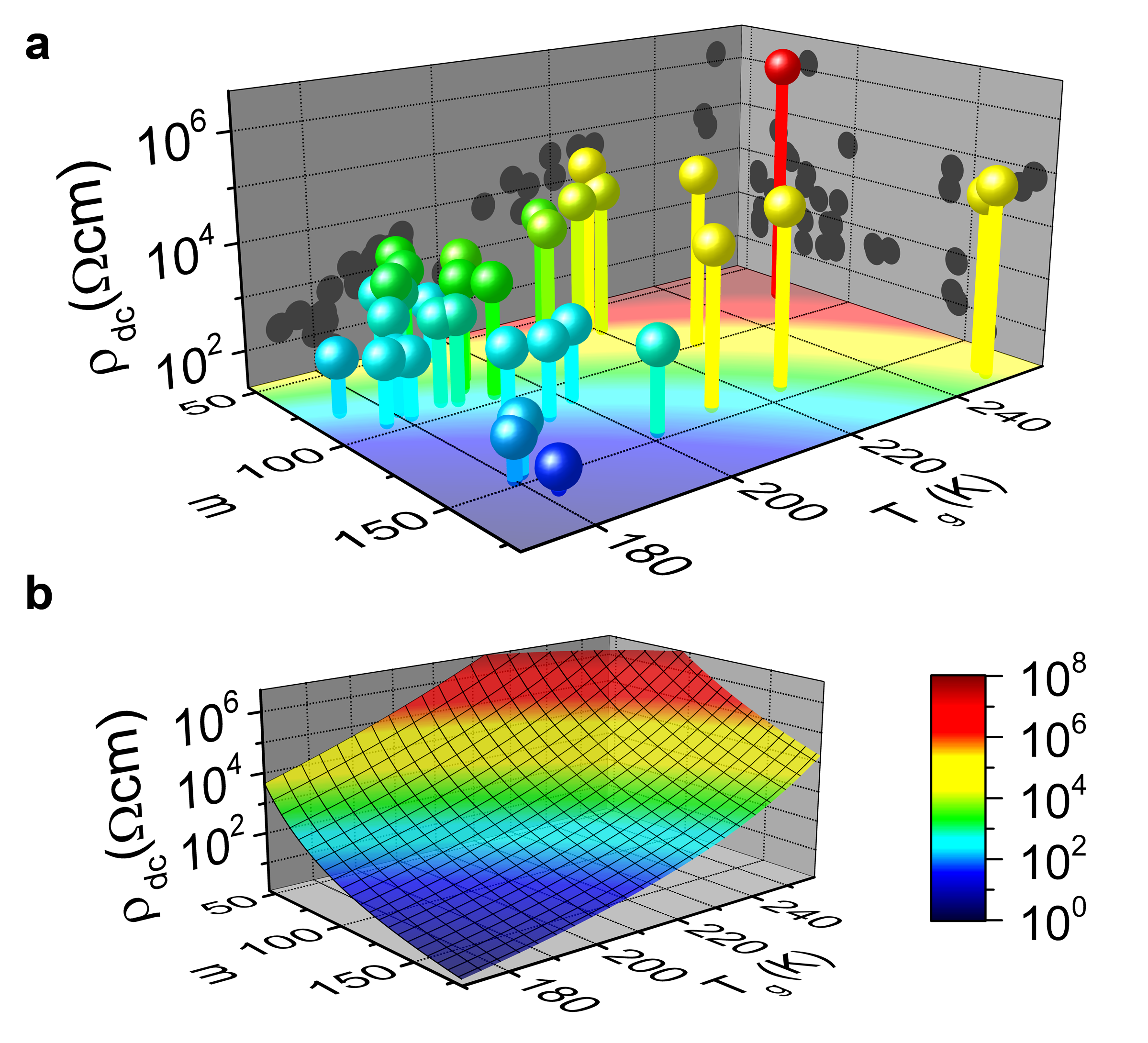
|
An example of our research on ionic liquids: The room-temperature
resistivity of various ionic liquids is related to their different
glass temperatures Tg and "fragilities" m (the
latter characterizes the non-canonical temperature dependence of their
resistivities). A systematic dependence on both quantities is revealed,
in agreement with a model calculation (frame b): We conclude that an ionic liquid should
exhibit small values of Tg and large m to ensure
low resistivity (i.e. high conductivity), which is prerequisite for
technical applications. [from: P. Sippel, P. Lunkenheimer, S. Krohns, E. Thoms, and A. Loidl, Importance of liquid fragility for energy applications of ionic liquids, Sci. Rep. 5, 13922 (2015).] |
b) Deep eutectic solvents:
In recent years, the so-called deep eutectic solvents (DESs) have attracted tremendous interest. They are considered a superior alternative to ionic liquids concerning low cost, environmental friendliness and low toxicity. DESs are multicomponent systems and, in their most common form, consist of a salt and a molecular hydrogen-bond donor, e.g., urea or glycerol. Mixing their two components generates the typical melting-point reduction of eutectics, making DESs liquid at room temperature. In this way, salts that are solid at room temperature can transform into a liquid state and, thus, become suited as solvents or electrolytes. DESs are promising for a various applications, including electrochemical ones. It is important to arrive at a better understanding of the ionic transport mechanism in DESs which should help finding optimized compounds for such applications.As schematically indicated in the figure below, a complex "zoo" of translational and reorientational
motions is possible in DESs [8]. Dielectric
spectroscopy is an ideal tool to investigate them because it is
sensitive to both translational ionic and reorientational dipolar motions. The aim of our research
[7,8,11,12,13,14,15] is clarifying the coupling of the different dynamics and
the influence of this coupling on the technically relevant ionic conductivity. Moreover, we
investigate the glass transition usually occurring in these materials, and its effect on the
conductivity.
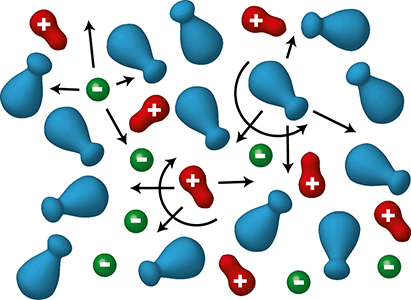
|
Different dynamic processes in a typical DES (e.g., glyceline = glycerol + choline chloride) [8]. Both the neutral hydrogen-bond-donor molecules (blue; glycerol) and the dipolar cations (red; choline+) can rotate. The ionic conductivity is caused by translational motions of the Cl- (green) and the choline+ ions (for glyceline). |
To check the coupling of ionic and dipolar dynamics, figures as shown below are very instructive. Here the ionic dc resistivities of various DESs and ionic liquids, measured at different temperatures, are plotted versus their relaxation times that quantify the dipolar rotation dynamics. A double-logarithmic scale is used and the lines with slope one correspond to ρ ∝ τ, which means perfect coupling. For some materials, significant deviations show up. Understanding them and also the size of the proportionality factor can pave the way for the development of better electrolytes [8,9].
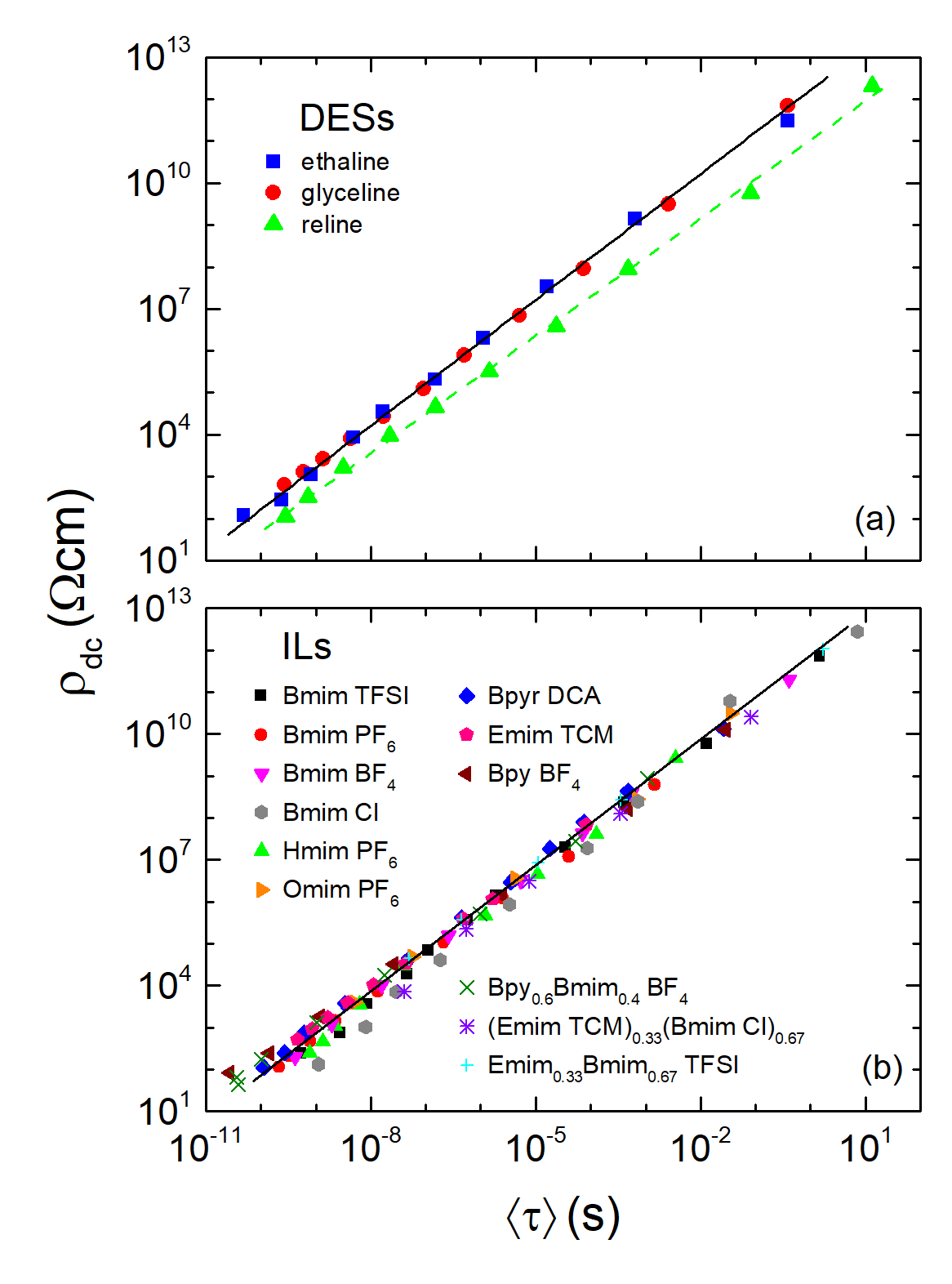
|
Dependence of the ionic dc resistivities of various DESs and ionic liquids
on their reorientational relaxation times. The solid lines with slope one indicate
linear behaviour, ρ ∝ τ.
[from: D. Reuter, C. Binder, P. Lunkenheimer, and A. Loidl, Ionic conductivity of deep eutectic solvents: the role of orientational dynamics and glassy freezing, Phys. Chem. Chem. Phys. 21, 6801 (2019).] |
c) Plastic crystals:
When ions are added to
plastic crystals,
some of them can exhibit sizable ionic conductivity reaching
technically relevant conductivity values. Such materials represent solid-state electrolytes, which could be
of high relevance for the development of batteries, fuels cells, etc. They avoid shortcomings of liquid
electrolytes (leakage, volatility, flammability, toxicity) and are considered as alternatives to polymer
electrolytes (polymer/salt mixtures).
| For a possible explanation of their high ionic mobility, one may consider that the typical molecular reorientations in the plastic crystal phase enhance the conductivity via a paddle-wheel or revolving-door mechanism as schematically indicated to the right. |
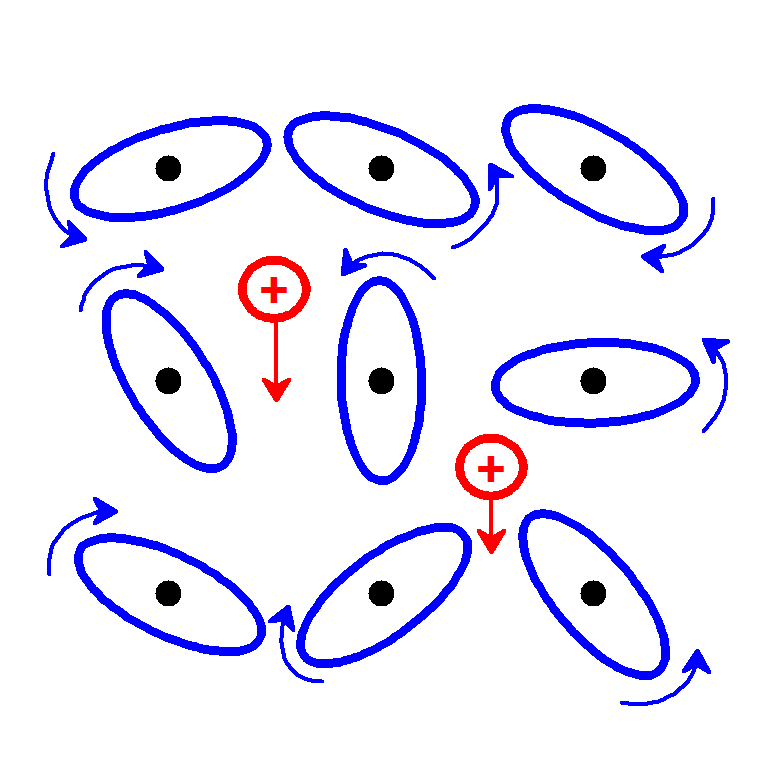
|
Dielectric spectroscopy can provide information on both, the translational dynamics of the ions and the reorientational motions of the dipoles in plastic crystals. From our investigations, we conclude that the revolving-door effect indeed can enhance the ionic mobility [5,9,10]. Moreover, we find that adding large molecules to plastic-crystalline materials can enhance the conductivity by several decades, most likely via an optimization of the revolving-door mechanism (see figure below) [5].
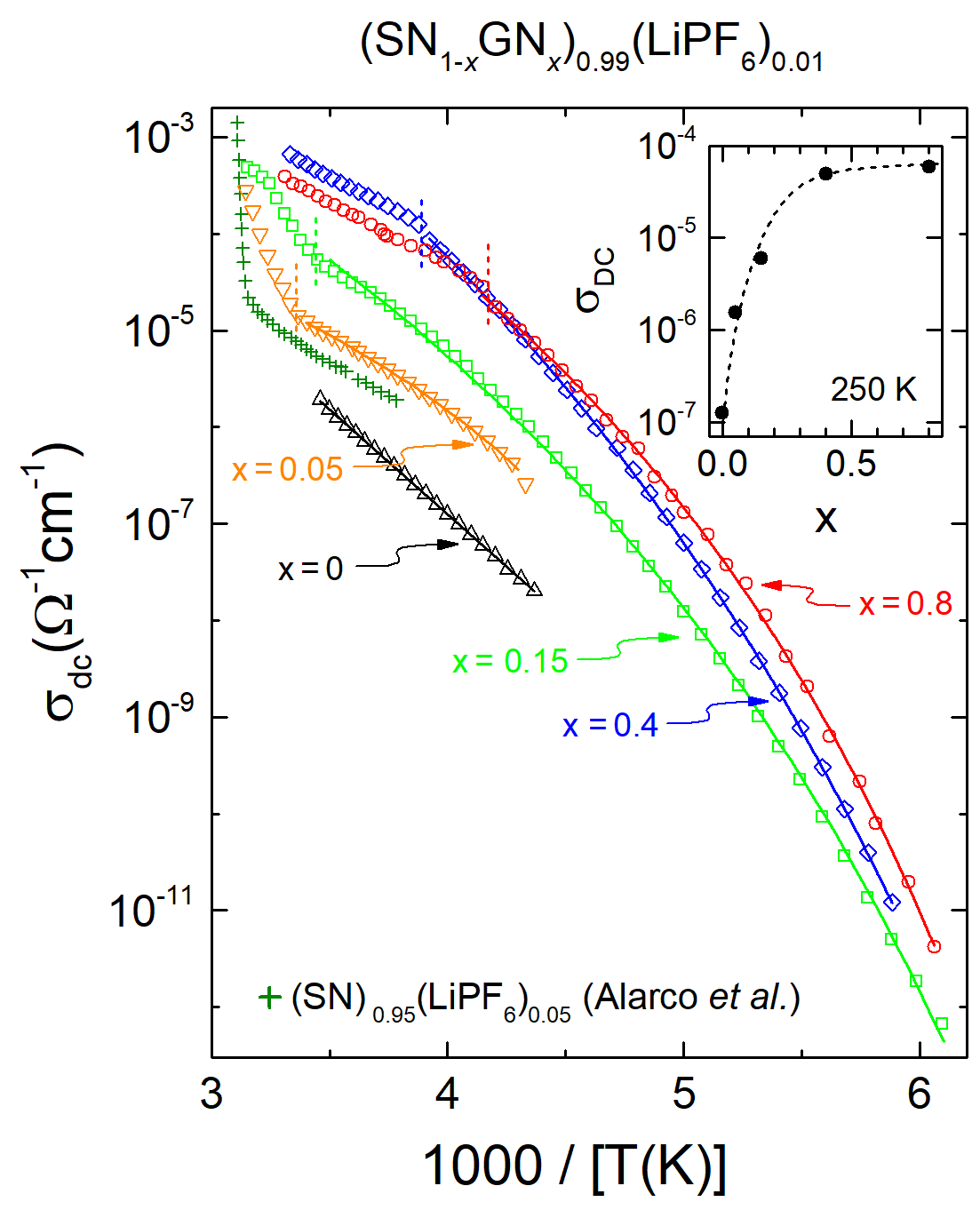
|
Dc conductivity of glutaronitrile/succinonitrile (SN/GN) mixtures with 1% LiPF6.
Adding larger GN molecules to SN strongly enhances the ionic
conductivity. The plusses show the results for pure SN, doped with 5%
LiPF6 as published by Alarco et al. [Nat. Mater. 3, 476 (2004)].
The inset shows the dependence of the conductivity on the SN concentration.
[from: Communication: Conductivity enhancement in plastic-crystalline solid-state electrolytes, K. Geirhos, P. Lunkenheimer, M. Michl, D. Reuter, and A. Loidl, J. Chem. Phys. 143, 081101 (2015).] |
3. Some relevant publications from our group:
| [1] | Ionic conductivity and relaxations in ZrO2-Y2O3
solid solutions A. Pimenov, J. Ullrich, P. Lunkenheimer, A. Loidl, and C.H. Rüscher, Solid State Ionics 109, 111 (1998). |
| [2] | Electrode polarization effects in broadband dielectric spectroscopy S. Emmert, M. Wolf, R. Gulich, S. Krohns, S. Kastner, P. Lunkenheimer, and A. Loidl, Eur. Phys. J. B 83, 157 (2011). |
| [3] | Li+ transport in poly(ethylene oxide) based electrolytes: Neutron scattering,
dielectric spectroscopy, and molecular dynamics C. Do, P. Lunkenheimer, D. Diddens, M. Götz, M. Weiß, A. Loidl, X.-G. Sun, J. Allgaier, and M. Ohl, Phys. Rev. Lett. 111, 018301 (2013). [PDF] |
| [4] | Importance of liquid fragility for energy applications of ionic liquids P. Sippel, P. Lunkenheimer, S. Krohns, E. Thoms, and A. Loidl, Sci. Rep. 5, 13922 (2015). [PDF] |
| [5] | Communication: Conductivity enhancement in plastic-crystalline solid-state
electrolytes K. Geirhos, P. Lunkenheimer, M. Michl, D. Reuter, and A. Loidl, J. Chem. Phys. 143, 081101 (2015). [PDF] |
| [6] | Importance of reorientational dynamics for the charge transport in ionic liquids P. Sippel, S. Krohns, D. Reuter, P. Lunkenheimer, and A. Loidl, Phys. Rev. E 98, 052605 (2018). [PDF] |
| [7] | Glycerol hydrogen-bonding network dominates structure and collective dynamics in a deep eutectic solvent A. Faraone, D.V. Wagle, G.A. Baker, E.C. Novak, M. Ohl, D. Reuter, P. Lunkenheimer, A. Loidl, and E. Mamontov, J. Phys. Chem. B 122, 1261 (2018). |
| [8] | Ionic conductivity of deep eutectic solvents: the role of orientational
dynamics and glassy freezing D. Reuter, C. Binder, P. Lunkenheimer, and A. Loidl, Phys. Chem. Chem. Phys. 21, 6801 (2019). |
| [9] | Plastic-crystalline solid-state electrolytes: Ionic conductivity and orientational
dynamics in nitrile mixtures D. Reuter, P. Lunkenheimer, and A. Loidl, J. Chem. Phys. 150, 244507 (2019). [PDF] |
| [10] | Ionic conductivity and relaxation dynamics in plastic crystals with nearly
globular molecules D. Reuter, K. Seitz, P. Lunkenheimer, and A. Loidl, J. Chem. Phys. 153, 014502 (2020). [PDF] |
| [11] | Translational and reorientational dynamics in deep eutectic solvents D. Reuter, P. Münzner, C. Gainaru, P. Lunkenheimer, A. Loidl, and R. Böhmer, J. Chem. Phys. 154, 154501 (2021). [PDF] |
| [12] | Lithium-salt-based deep eutectic solvents: Importance of glass formation
and rotation-translation coupling for the ionic charge transport A. Schulz, P. Lunkenheimer, and A. Loidl, J. Chem. Phys. 155, 044503 (2021). [PDF] |
| [13] | Rotational dynamics, ionic conductivity, and glass formation in a ZnCl2-based deep eutectic solvent A. Schulz, P. Lunkenheimer, and A. Loidl, J. Chem. Phys. 160, 054502 (2024). [PDF] |
| [14] | Translational and reorientational dynamics in carboxylic acid-based deep eutectic solvents A. Schulz, K. Moch, Y. Hinz, P. Lunkenheimer, and R. Böhmer, J. Chem. Phys. 160, 074503 (2024). [PDF] |
| [15] | Ionic conductivity of a lithium-doped deep eutectic solvent: Glass formation and rotation-translation coupling A. Schulz, P. Lunkenheimer, and A. Loidl, J. Phys. Chem. B 128, 3454 (2024). |
| [16] | Coupling and decoupling of molecular reorientation and charge transport
in Li-salt-doped cycloalcohol ion conductors S. Lansab, Y. Hinz, B. Grabe, P. Lunkenheimer, and R. Böhmer, Phys. Chem. Chem. Phys. 27, 16161 (2025). [PDF] |